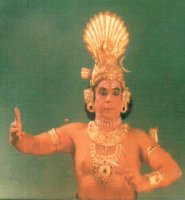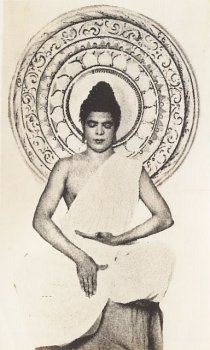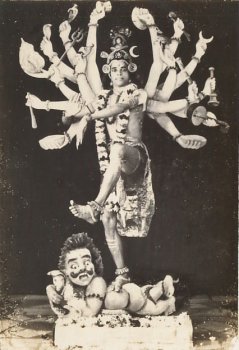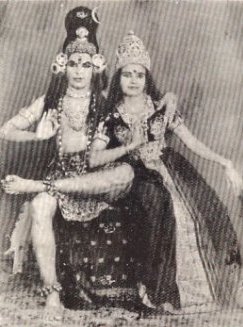Narthaki

News

Info

Featured

 |
  |
Guru Chandrasekharan (1916 - 1998) - KP Nair Photos courtesy: Santhikumar Chandrasekharan February 8, 2009  Guru Chandrasekharan was a great dancer and choreographer who was born in Trivandrum in 1916. His father was artist NK Nair (Kunju Krishna Kurup), a notable oil painter. While studying at the university, he started practicing dance. Without informing his parents, he studied Kathakali under the guidance of Guru Gopinath. During that period, Gopinath received royal patronage from the Travancore palace and a dance school named 'Sri Chithrodaya Nartha Kalalayam' was established by the Government at Poojappura, Travancore. Chandrasekharan was a student of that school. After some time, Chandrasekharan learnt Kathakali under Nedumudi Narayana Kurup who was also a palace artiste. Later, he organized his own troupe and conducted performances in important cities of India. During that period, social themes were rarely used in classical dances. He directed and choreographed several social themes in dance form. In 1943 on an invitation from the Government, he took his troupe to Alexandria (Egypt), Middle East and Italy for military entertainment as the Indian Army was engaged in World War II. At the close of the war in 1946, he again tried to go to the Far East, but the tour ended at Jafna, in Ceylon. He served as a dance professor at Shantiniketan, West Bengal, as member of the Kerala University Senate, Board of Directors at Kerala Kalamandalam Governing body, Advisory Committee member Malayalam Encyclopedia and visiting dance professor of Swathi Thirunal College of Music.  In the late forties, at the insistence of some of his friends, he composed and presented the 'Voice of Travancore,' a political theme in dance form, which depicted the autocratic rule of the Dewan, Sir CP Ramaswamy Iyer and people's movement of resistance thereon. However, Sir CP was an admirer of Chandrasekharan's art and every year he used to arrange his dance programs at his official residence at Bhaktivilas. He received his highest honour when he was praised in the report published by the All India Educational Conference held in Trivandrum in 1946. According to the report: "The Nataraja Thandava was presented in a remarkable manner by Chandrasekharan. When he presented the Hunter Dance, his joy of being the monarch of all he surveyed in the forest was vividly perceivable. He aroused tragic sentiments to a remarkable extent while he was experiencing suicidal agony as he was bitten by a snake. As he entered 'Ardhanareeswara,' here the body was responding to a double call of vigour and grace. It was perhaps more than what an Uday Shankar could do." Another composition of his is 'Polinja Deepam' (The light that failed) depicting the sad end of Mahatma Gandhi, which he played in 1948. In 1949 he joined the Viswabharathi University (Shantiniketan) as a Professor of Kathakali dance. During this period, he composed and portrayed Rabindranath Tagore's famous dance dramas, 'Chitrangada,' 'Chandalika' etc. in various cities of North India including New Delhi and Calcutta. In Viswabharathi, he had the opportunity to get acquainted with various dance forms including those from Kandi, Bali, Burma etc. During this period in Shantiniketan, he got acquainted with Prof. Humayun Kabir, Zakir Hussain (Former President of India) who were then frequent visitors of Shantiniketan. These great men were all praise for the young dancer: "Chandrasekharan has great expressiveness and was able to communicate shades of feeling with subtlety and power. His sense of rhythm and dramatic interpretation marks him out as an artist of distinction." Poet Harindranth Chatopadhyaya wrote to him on February 21, 1952. "Courage is this that single willed, unaided lone you build and build Which shows you have the spirits pluck, so from the heart I wish you luck."  SK George, a Gandhian disciple and a former Director of Deenabandhu Bhavan, Shantiniketan, said about him: "Sri Chandrasekharan was one of the best teachers of Art that Shantiniketan has had and did much to rouse interest in its study among students from various parts of the country. He delighted visitors to Shantiniketan from all parts of the world during his stay there, by the finished technique of his art and has received glowing testimonials from many of them, including delegates to the World Pacifist meeting. In Gurudev's dance dramas like 'Chandalika,' 'Chitrangada' and 'Syama' presented in Shantiniketan and outside, he took the leading parts." After a couple of years, he came back from Viswabharathi and started his own school at Trivandrum in the name Prathibha Nrithakala Kendra. During 1954, he performed 'Thilakkunna Mannu' (Simmering Sand) that had a social theme advocating agrarian revolution. It received wide acclamation from celebrated persons like President Rajendra Prasad and Dr. Radhakrishnan. Chandrasekharan's creative contributions include such compositions as 'Voice of Travancore,' 'Manishada,' 'Siva Thandavam,' 'Ganesh Nritham,' 'Ardhanareeswara,' 'Surya Nritham,' 'Geethopadesam,' Kalidasa's 'Kumara Sambhavam,' 'Sakunthalam,' Kumaran Asan's 'Chandala Bhikshuki,' Vallathol's 'Magdalana Maria,' 'Guruvum Sishyanum,' Vayalar's 'Ayisha,' Changampuzha's 'Ramanan' and 'Markandeyan,' 'Mohini Rugmangada,' 'Savithri,' 'Dakshayagam,' 'Ekalavyan,' 'Chilappadikaram,' Greek story 'Pygmalion,' Chinese story 'Fisherman's Revenge,' Japanese story 'Esashiyuvo' (Prapidiyan Pathalathil), Bible story 'Salome' and a lot more. He successfully composed and performed several ballets such as 'Sri Guruvayurappan,' 'Kumara Sambhavam,' 'Sri Ayyappan,' 'Hrishya Sringan' and 'Sri Hanuman.' He produced another ballet named 'Himavante Makkal' (Children of the Himalayas) in 1964 on the background of the India's history, which concluded with the Chinese attack on India in 1962. After seeing it, VV Giri, then Governor of Kerala, was so happy that he invited Chandrasekharan to Raj Bhavan and honored him. Here is an extract from his complimentary remarks. "I am delighted to witness the performance of a dance drama based on National Integration presented by Pratibha Nrithakala Kendra, Trivandrum, and directed by the famous and distinguished dancer Chandrasekharan. This play describes the various periods through which we have passed from Vedic period up to the present day. It is a most thought provoking play and one who attends this show will feel enthused and inspired and would strengthen his spirit of patriotism and love of sacrifice for his country."  Guru Chandrasekharan and Mohanavalli In 1965, Chandrasekharan composed an opera which was the first of its kind in Malayalam as well as in any other Indian language. The opera was based on the Mahabharata character Karnan. Chandrasekharan himself played the role of Karna while nearly hundred others took part in it, which was presented in Trivandrum for more than a month. The opera was produced by Kala Nilayam Theatres of late Thaniniram Krishnan Nair. Chandrasekharan later produced another opera entitled 'Bhishmar' on the Mahabharata hero which was an artistic success, but financially a flop, which forced him to withdraw from the scene partly. However, he continued his activities till 1980. At a public meeting in connection with his Shashtiabdapurthi (60th birthday) at Hassan Marrikar Hall, Trivandrum, under the Chairmanship of Prof. Ayappa Panicker, he was conferred the title of 'Guru' by the public of Trivandrum. He was honoured with an Award by Kerala Sangeetha Nataka Academy in 1976. Chandrasekharan has written several articles in periodicals about various dances of India. His book on Bharatanatyam titled Natiya Nirishanam is a masterpiece, the culmination of a research work done with a Fellowship Award from the Cultural Department, Government of India. Chandrasekharan married Mohanavalli Amma of Kalappurakkal family, Alangad Paravur and daughter of Gopala Panicker, Asst. Superintendent of Police in former Travancore State. Due to his bitter experiences in the field of art, he did not encourage his children to accept dance as a profession. His elder son, Santhikumar, is working in Canada and younger son, Krishna Kumar, is an officer in the Sports Authority of India. His daughters Ragini and Renuka are housewives. He passed away on 5th August 1998 at the age of 82. K Parameswaran Nair is the youngest brother of Guru Chandrasekharan. |